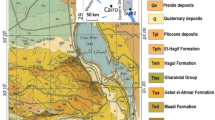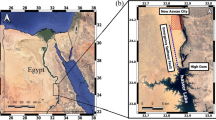Abstract
Since November 14, 1981 earthquake (ML 5.6), about 60 km southwest of Aswan High Dam, the seismic hazard raised and the Aswan Local Seismic Network (ALSN) has recorded and precisely monitored the seismic activity in the vicinity of the High Dam. The major source of seismic activity in this region is the active Kalabsha Fault Zone (KFZ). The focal mechanism solutions indicate that two nodal planes strike E to ENE, with subordinate right-lateral strike-slip component and N to NNW, with left-lateral movement. The directions of tectonic extension (T) and compression (P) are NNE-SSW and NNW-SSE, respectively. Structural investigations and application of the Electromagnetic Radiation (EMR) technique reveal ongoing activity on the KFZ. Kinematic evolution of the KFZ implies faulting events with a strong movement intervened with periods of severe crushing, grinding, and even pulverization. Such tectonic processes have resulted in fault-breccia and fault-gouge. Results obtained from the present study indicate that the KFZ is not a single transcurrent wrench fault with dextral sense of movement but, instead, it represents a major dextral transtensional shear or fault zone deforming southern Egypt and plays a significant role in the structural sha** of the area to the west of Nasser Lake. Furthermore, the activity on the KFZ is most probably controlling the seismic cycle in the area. Topographic expression of KFZ is evidently realized at Sinn El-Kaddab scarp, as well as at Gebel Marawa. Frequent surface rupturing and newly recorded strong seismic activity advocate faulting reactivation supported by the EMR data, which suggest an active fault system oriented ENE-WSW and NNW-SSE affecting the KFZ, with a maximum horizontal stress (σ1) perturbing between ENE and NNW directions.













Similar content being viewed by others
References
Abdeen MM, Abdelsalam MG, Nielsen KC, Yehia MA, Cherif OH (2000) Active dextral wrenching in southern Egypt. In 38th Annual Meeting of the Geological Society of Egypt, Cairo, November
Abdelazim M, Samir A, El-Nader IA, Badawy A, Hussein H (2016) Seismicity and focal mechanisms of earthquakes in Egypt from 2004 to 2011. NRIAG J Astron Geophys 5(2):393–402
Abu Elenean KM (1997) A study on the seismotectonics of Egypt in relation to the Mediterranean and red seas tectonics. Ph. D. Thesis, Faculty of Science, Ain Shams University, Cairo, Egypt
Abu Elenean KM (2007) Focal mechanisms of small and moderate size earthquakes recorded by the Egyptian National Seismic Network (ENSN), Egypt. NRIAG J Geophys 6(1):119–153
Ambraseys NN (1971) Value of historical records of earthquakes. Nature 232:375–379
Ambraseys NN, Melville CP, Adams RD (1994) The seismicity of Egypt, Arabia and the Red Sea. A historical Review, Cambridge
Attia MI (1955) Topography, geology and iron-ore deposits of the district east of Aswan: Cairo. Egypt. Geol. Survey Dept, Abbassia, Egypt
Awad M, Mizoue M (1995) Earthquake activity in the Aswan region, Egypt. Pure Appl Geophys 145(1):69–86
Badawy A (1995) Source parameters and tectonic implications of recent Sinai (Egypt) earthquakes. Acta Geod Geoph Hung 30:349–361
Badawy A (1996) Seismicity and kinematic evolution of the Sinai plate. Ph.D. thesis, L. EotvosUniv ., Budapest
Badawy A (1998) Historical seismicity of Egypt. Acta Geod Geoph Hung 34(1–2):119–135
Badawy A (2001) Status of the crustal stress in Egypt as inferred from earthquake focal mechanisms and borehole breakouts. Tectonophysics 343(1):49–61
Bahat D, Rabinovitch A, Frid V (2005) Tensile fracturing in rocks-tectonofractographic and electromagnetic radiation methods, vol 16. Springer, 570 pp
El Etr HA, Yehia MA, Dowidar H (1982) Fault pattern in the south Western Desert of Egypt. Ain Shams Univ Sci Res Ser 2:123–152
El-Hady SM, Khalil AE, Hosny A (2004) 1-D velocity structure in northern of Aswan Lake, Egypt deduced from travel time data. J Appl Geophys 3(1):55–62
El-Shazly MS (1954) Rocks of Aswan area. Governmental Press
Fat-Helbary R, Tealeb A (2000) A study of seismicity and earthquake loading at the proposed Kalabsha dam site, Aswan, Egypt. Bulletin of NRIAG B, 39-61
Greiling RO, Obermeyer H (2010) Natural electromagnetic radiation (EMR) and its application in structural geology and neotectonics. J Geol Soc India 75(1):278–288
Guiraud R, Bosworth W (1997) Senonian basin inversion and rejuvenation of rifting in Africa and Arabia: synthesis and implications to plate scale tectonics. Tectonophysics 282:39–82
Guiraud RO, Bosworth W (1999) Phanerozoic geodynamic evolution of northeastern Africa and the northwestern Arabian platform. Tectonophysics 315(1):73–104
Guiraud RO, Issawi B, Bosworth W (2001) Phanerozoic history of Egypt and surrounding areas. Peri-Tethys Memoir 6:469–509
Hagag W, Obermeyer H (2017) Active structures in central Upper Rhine Graben, SW Germany: New data from Landau area using Electromagnetic Radiation (EMR) Technique and Cerescope. J. Geol. Geophys 6(5) in press
Haggag HM, Gaber HH, Sayed AD, Ezzat ME (2008) A review of the recent seismic activity in the southern part of Egypt (upper Egypt). Acta Geodyn Geomater 5(1):19–29
Hamimi Z, Hagag W (2017) A new tectonic model for Abu-Dabbab seismogenic zone (Eastern Desert, Egypt): evidence from field-structural, EMR and seismic data. Arab J Geosci 10(1):11
Hassib GH (1997) A study on the earthquake mechanics around the high dam Lake, Aswan, Egypt. Ph. D. Thesis, Faculty of Science, South Valley University, Sohag, Egypt
Hogan JP, Tewksbury BJ, Mehrtens C, Ellis T (2013) The Desert Eyes project Part II: Structures along East-West and North-South faults of the Western Desert, Egypt. In Geological Society of America Abstracts with Programs 45(7), p. 160
Hosny A, Ali SM, Abed A (2014) Study of the 26 December 2011 Aswan earthquake, Aswan area, south of Egypt. Arab J Geosci 7(11):4553–4562
Hussein HM, Elenean KA, Marzouk IA, Korrat IM, El-Nader IA, Ghazala H, El Gabry MN (2013) Present-day tectonic stress regime in Egypt and surrounding area based on inversion of earthquake focal mechanisms. J Afr Earth Sci 81:1–15
Issawi B (1968) The geology of Kurkur-Dungle area. Geol Surv Egypt, paper 46, p. 102
Issawi B (1969) The geology of KurkurDungul area.US Government Printing Office
Issawi B (1973) Nubia sandstone: type section. AAPG Bull 57(4):741–745
Issawi B (1978) Geology of Nubia west area, Western Desert, Egypt. Ann Geol Surv Egypt 8:237–253
Issawi B (1982) Geology of the Southwestern Desert of Egypt. Annal Geol Surv of Egypt
Issawi B (1987) Geology of the Aswan Desert. Annals Geol. Survey of Egypt
Issawi B, Jux U (1982) Contributions to the stratigraphy of the Paleozoic rocks in Egypt. Geol. Surv. of Egypt
Issawi B, Osman RA (1993) Tectonic-sedimentary synthesis of Paleozoic-cretaceous clastics, SW Aswan, Egypt. J Sed Egypt 1:11–22
Kebeasy RM, Tealab A (1997) Earthquake activity and subsurface structures of south valley project. Internal report. Natl Res Inst Astron Geophys 14:1–87
Kebeasy RM, Maamoun M, Ibrahim EM (1981) Lake Aswan induced earthquake. Bull Internal Inst Seismol Earthq Eng 19:155–160
Kebeasy RM, Maamoun M, Ibrahim E, Megahed A, Simpson DW, Leith WS (1987) Earthquake studies at Aswan reservoir. J Geodyn 7(3–4):173–193
Khalil AE, El-Hady SM, Hosny A (2004) Three-dimensional velocity structure of VP and VP/VS around Aswan area, Egypt.J Appl. Geophys 3(1):303–314
Klein FW (1978) Hypocenter locations program HYPOINVERSE. US Department of the Interior, Geological Survey
Lauterbach M (2005) Beurteilung der Eignung der NPEMFE-Methode (Natural Pulsed Electromagnetic Field of Earth) mit dem “Cereskop” in Rutschungen und in Lockerund Festgesteinen mit Spannungsänderungen im Mittel- und Hochgebirge Ph.D. Thesis University of Mainz , 243 pp.
Lichtenberger M (2005) Regional stress field as determined from electromagnetic radiation in a tunnel. J Struct Geol 27:2150–2158
Lichtenberger M (2006a) Bestimmen von Spannungen in der Lithosphäre aus geogener elektromagnetischer Strahlung. Ph.D. Thesis University of Heidelberg (140 pp)
Lichtenberger M (2006b) Underground measurements of electromagnetic radiation related to stress-induced fractures in the Odenwald Mountains (Germany). Pure Appl Geophys 163:1661–1677
Maamoun M, Megahed A, Allam A (1984) Seismicity of Egypt. Bull Helwan Inst Astron Geophys 4(B):109–132
Mahmoud SM (1994) Geodetic and seismotectonic deformation near Aswan reservoir, Egypt. Bulletin of CRCM 41, Praha, Czech Republic, pp. 5–30
Mallik J, Mathew G, Angerer T, Greiling RO (2008) Determination of directions of horizontal principal stress and identification of active faults in Kachchh (India) by electromagnetic radiation (EMR). J Geodyn 45:234–245
Mekkawi M, Abdel-Monem SM, Rayan A, Mahmoud S, Saleh A, Moustafa S (2008) Subsurface Tectonic Structure and Crustal Deformation at Kalabsh fault, Aswan, Egypt from Magnetic, GPS and Seismic data. NRIAG J Geophys, special issue, pp 681–700
Meshref WM (1990) Tectonic framework of Egypt. In: Said R (ed) Geology of Egypt. A.A. Balkema Publisher, Netherland, pp 113–153
Obermeyer H (2001) Handbuch zur Anwendung der EMR-Methode mittels des Cereskops. Ceres GmbH, Staffort (32 pp)
Obermeyer H (2005) Measurement of natural pulsed electromagnetic radiation (EMR) with the Cerescope. Ceres GmbH, Staffort
Obermeyer H, Lauterbach M, Krauter E (2001) Monitoring landslides with natural electromagnetic pulse radiation. In: International Conference on Landslides, pp. 297–304
Reuther C, Moser E (2009) Orientation and nature of active crustal stresses determined by electromagnetic measurements in the Patagonian segment of the South America plate. Int J Earth Sci 98:585–599
Reuther C, Obermeyer H, Reicherter K, Reiss S, Kaiser A, Buchmann T, Adam J, Lohrmann J, Grasso M (2002) Neotectonic und active Krustenspannung in Südost- Sizilien und ihre Beziehungzurregionalen Tektonikim Zentralen Mittelmeer. Mitt Geol Palaontol Inst Univ Hamburg 86:1–24
Spinks SC, Parnell J, Bowden SA (2010) Reduction spots in the Mesoproterozoic age: implications for life in the early terrestrial record. Int J Astrobiol 9(4):209–216
Stern RJ, Abdelsalam MG (1996) The origin of the great bend of the Nile from SIR-C/X-SAR imagery. Science 274(5293):1696–1698
Suetsugu D (1998) Practice on source mechanism II SEE lecture note. Tsukuba, Japan, 104 pp
Taha YS (1997) Evaluation of the crustal structure setting of Aswan area. Ph.D. thesis, Faculty of Science, Cairo University, Egypt, 152 p
Tealeb A (1999) Proposed programs for monitoring crustal deformations at seismoactive area of Aswan, Egypt using geodetic techniques.Internal Report at NRIAG, 81p
Tewksbury B, Abdelsalam MG, Hogan JP, Jerris TJ, Pandey A (2009) Reconnaissance study of domes and basins in Tertiary sedimentary rocks in the Western Desert of Egypt using high resolution satellite imagery. In Geological Society of America Abstracts with Programs 41, No. 7, p. 458
Thurmond AK (2002) Understanding the structural control of the Nile through Batn El Hajar region, Northern Sudan using remote sensing imagery. M.Sc. thesis, Department of Geosciences, University of Texas at Dallas, pp. 348
Thurmond AK, Stern RJ, Abdelsalam MG (2000) Structural analysis of the cataract Nile in northern Sudan using Landsat TM and SIR-C/X-SAR Imagery.Abstract, international conference on the Western Desert, NARSS-EGSMA, p.12-13
Thurmond AK, Allison K, Stern RJ, Mohamed G, Abdelsalam MG, Kent D, Nielsen C, Abdeen MM, Hinz E (2004) The Nubian swell. J Afr Earth Sci 39:401–407
Woodward-Clyde Consultants (1985) Earthquake activity and stability evaluation for the Aswan high dam. Unpublished report, High Aswan and Dam Authority, Ministry of Irrigation, Egypt
Acknowledgments
Authors would like to thank Prof. Awad Hassoup, Head of Seismology Department in the National Research Institute of Astronomy and Geophysics (NRIAG), for great help and offering facilities for data to achieve this work. We are also grateful to Prof. Hesham Hussein, Head of National Data Center (NRIAG), for fruitful recommendations, and to Dr. Saud Abdallah in Seismology Department (NRIAG) for helpful cooperation.
Author information
Authors and Affiliations
Corresponding author
Additional information
This article is part of the Topical Collection on Current Advances in Geology of North Africa
Rights and permissions
About this article
Cite this article
Hamimi, Z., Hagag, W., Osman, R. et al. The active Kalabsha Fault Zone in Southern Egypt: detecting faulting activity using field-structural data and EMR-technique, and implications for seismic hazard assessment. Arab J Geosci 11, 421 (2018). https://doi.org/10.1007/s12517-018-3774-1
Received:
Accepted:
Published:
DOI: https://doi.org/10.1007/s12517-018-3774-1




